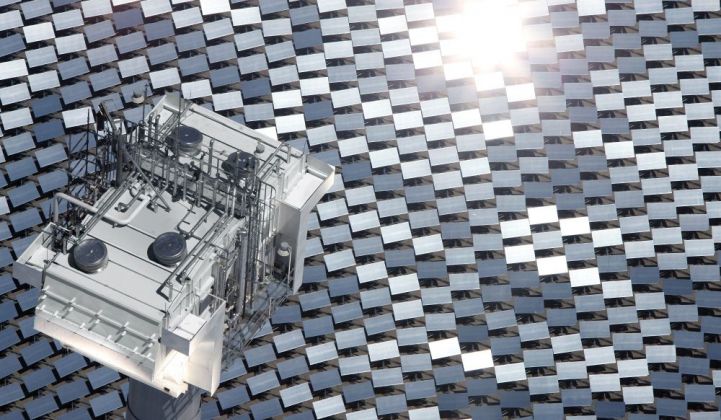Winter clouds may help the Mojave Desert bloom but they can be a burden for concentrated solar power (CSP), Energy Information Administration figures show.
According to the EIA’s Electric Power Monthly report, U.S. CSP or solar thermal plants had a capacity factor of less than 22 percent in 2017, the lowest of any renewable energy technology in the country.
The figure is 5 percent below solar PV and also much less than typical CSP capacity factors found in other published sources.
In theory, CSP under sunny conditions should be able to beat PV’s capacity factors because it is not as directly dependent on sunlight for electricity generation, even without storage.
Under normal operations, the temperature of a CSP plant’s heat transfer fluid and the inertia of its turbine could potentially give the plant a measure of ride-through capacity that might enable it to carry on generating electricity during moments of cloud cover.
For this reason, published sources usually give even moderately inefficient CSP technologies a capacity factor equal to or higher than that typically achieved with PV.
The International Renewable Energy Agency, for example, estimates an average capacity factor of between 25 percent and 28 percent for zero-storage parabolic trough CSP, the most commonly used plant design in the U.S.
The EIA’s low capacity factors for CSP led some experts to question the data.
“I have no idea how they determined the capacity factor for CSP, but I do know that for Solana it is 41 percent and for Mojave it is 29 percent,” said Fred Morse, president of clean energy consultancy Morse Associates.
The Mojave figure is significant because it is for a parabolic trough plant that does not have thermal storage, which is the case for most of the U.S. CSP fleet.
It is also consistent with published figures for CSP capacity factors in other plants without storage, including PS 20 in Spain, with a capacity factor of 27 percent, and eSolar’s Sierra SunTower in California, with 30 percent.
But there could be good reasons for the EIA to be recording a figure that is significantly lower. For a start, the EIA data set includes output from the oldest commercial CSP complex on the planet, the Solar Electric Generating Station (SEGS).
The plants that make up SEGS were designed and largely commissioned in the 1980s. Although a couple of units have now been decommissioned, there are still 310 megawatts of operational plant, National Renewable Energy Laboratory records show.
The SEGS parabolic trough complex has an admirable operational record but is unlikely to boast the efficiency of newer projects such as Mojave. And closer inspection of the EIA data shows that its location may not be helping.
Although SEGS’ siting in the Mojave Desert was intended to capture some of best solar resource in the U.S., clouds start to roll into the region from November and by February the location can be overcast more than 50 percent of the time.
This coincides with a significant dip in the monthly CSP capacity factors recorded by the EIA. In January 2016 and 2017, for example, the average U.S. capacity factor for CSP was only around 7 percent.
Meanwhile, PV, which is able to produce some electricity even under cloud cover, mustered more than a 15 percent capacity factor nationwide in January 2016 and nearly 17 percent over the same period in 2017.
For CSP advocates, the answer to low capacity factors is simple: Adding thermal storage can completely change the picture. Solana, for example, gets its 40+ percent capacity factor largely thanks to 6 hours of molten salt storage. And the CSP industry is well aware of this value.
“We see no reason any future CSP projects will be built unless they have significant storage,” said Kevin Smith, chief executive officer of SolarReserve, the developer of Crescent Dunes, a project with a 10-hour thermal store.
The problem CSP faces in the U.S. is that there is not much appetite to build new plants. And when the data makes it look as though it will deliver less energy for more than the cost of PV, there may be little incentive to change that.




